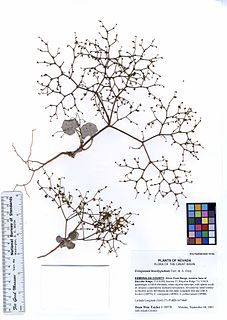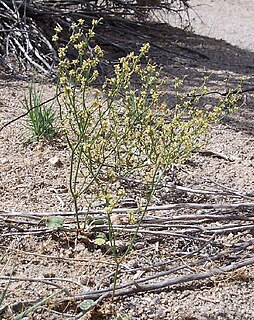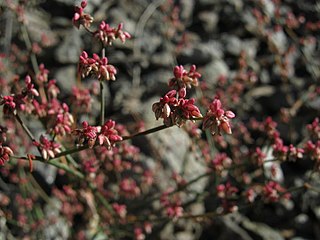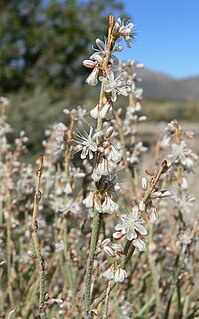
Eriogonum fasciculatum is a species of wild buckwheat known by the common names California buckwheat and flat-topped buckwheat. Characterized by small, white and pink flower clusters that give off a cottony effect, this species grows variably from a patchy mat to a wide shrub, with the flowers turning a rusty color after blooming. This plant is of great benefit across its various habitats, providing an important food resource for a diversity of insect and mammal species. It also provides numerous ecosystem services for humans, including erosion control, post-fire mitigation, increases in crop yields when planted in hedgerows, and high habitat restoration value.

Eriogonum brachypodum is a species of wild buckwheat known by the common name Parry's buckwheat. This annual herb is native to the southwestern United States from California to Utah and especially the Mojave Desert. It grows in sandy and gravelly substrates. It has a skeletonlike spindly stem which branches many times. It can grow 5 to 50 centimeters in height and up to a meter in width. There is an array of rounded, dark-colored leaves around the base. Leaves are a few centimeters long and fuzzy on the undersides. Most of the plant is actually the spreading inflorescence. At intervals on the otherwise naked branches hang tiny clusters of glandular flowers a few millimeters wide in involucres of bell-shaped bracts. Each flower is less than three millimeters wide.

Eriogonum cinereum is a species of wild buckwheat known by the common names coastal buckwheat and ashyleaf buckwheat.
Eriogonum intrafractum is a species of wild buckwheat known by the common names jointed buckwheat and napkinring. This plant is endemic to Inyo County, California, where it is known only from the mountain ranges surrounding Death Valley. It is an uncommon, distinctive perennial herb which grows in scattered patches on rocky limestone soils in these desert mountains.

Eriogonum strictum is a species of wild buckwheat known by the common name Blue Mountain buckwheat. It is a common plant of western North America from northern California to British Columbia where it is found along rocky slopes and scrubland. It flowers early in the summer.

Eriogonum wrightii is a species of wild buckwheat known by the common names bastardsage and Wright's buckwheat. It is native to the Southwestern United States, California, and northwest Mexico, where it grows in many plant communities, such as chaparral, in rocky habitats from mountains to deserts.

Eriogonum ampullaceum is a species of wild buckwheat known by the common name Mono buckwheat.

Eriogonum angulosum is a species of wild buckwheat known by the common name anglestem buckwheat.
Eriogonum argillosum is a species of wild buckwheat known by the common names clay buckwheat, clay-loving buckwheat, and Coast Range wild buckwheat. It is endemic to California, where it is known only from San Benito and Monterey Counties. It grows on clay substrates, often of serpentine origin. This is an annual herb up to 30 to 60 centimeters tall with a basal patch of oval-shaped, woolly leaves and a naked stem. The top of the stem is occupied by the inflorescence, a cyme with several clusters of tiny white or pink flowers.

Eriogonum brachyanthum is a species of wild buckwheat that is commonly known as shortflower buckwheat. It is native to eastern California and western Nevada, particularly the Mojave Desert region, where it is common to abundant, and even sometimes weedy. It is also known from southern Oregon. The plant grows in sandy habitats such as desert flats and sagebrush. It also grows in pinyon-juniper and montane conifer woodlands. It is an annual herb that grows 30 to 40 centimeters tall. Leaves are located at the base of the stem, woolly, and oval or rounded in shape. The top of the stem is occupied by a branching inflorescence bearing many widely spaced clusters of flowers. Each individual flower is about a millimeter wide and light yellow in color. Flowers bloom from April to November.

Eriogonum hoffmannii is a species of wild buckwheat known by the common name Hoffmann's buckwheat. It is endemic to Inyo County, California, where it is found only in the mountains around Death Valley; most of the known populations of the plant are located in Death Valley National Park. The plant grows in the desert scrub on the slopes of the Panamint, Black, and Funeral Mountains.

Eriogonum luteolum is a species of wild buckwheat known by the common name goldencarpet buckwheat. It is native to many of the mountain ranges of California and southern Oregon, including the Sierra Nevada, Cascades and California Coast Ranges. It grows in mountain and foothill habitat, such as forest and woodland, on granite and sometimes serpentine soils.
Eriogonum molestum is a species of wild buckwheat known by the common name pineland buckwheat. It is endemic to southern California, where it grows in the Transverse Ranges of Ventura County to the Peninsular Ranges of San Diego County.

Eriogonum panamintense is a species of wild buckwheat known by the common name Panamint Mountain buckwheat. It is native to several of the desert mountain ranges of eastern California and western Nevada, including the Panamint Range. It grows in various types of mountain ridge habitat, such as sagebrush and coniferous woodland.

Eriogonum parishii is a species of wild buckwheat known by the common name mountainmist.

Eriogonum sphaerocephalum is a species of wild buckwheat known by the common names rock buckwheat and round-headed desert buckwheat. It is native to the western United States.

Eriogonum ternatum is a species of wild buckwheat known by the common name ternate buckwheat. It is native to mountain ranges of northern California and southern Oregon, where it grows in the serpentine soil of the forests. This is a perennial herb forming mats up to half a meter wide with rosetted clusters of oval to rounded woolly leaves each about a centimeter long. The inflorescence arises on a flowering stem and bears an umbel of bright yellow flowers.

Eriogonum tripodum is a rare species of wild buckwheat known by the common name tripod duckwheat. It is endemic to California, where it is known from the Sierra Nevada foothills and northern sections of the Coast Ranges.

Eriogonum viridescens is a species of wild buckwheat known by the common name twotooth buckwheat. It is endemic to California, where it grows in the Central Coast Ranges through the Transverse Ranges and into the Mojave Desert, as well as in the Central Valley. It grows in a variety of habitat types, generally on clay and sandy soils.

Eriogonum callistum is a rare species of wild buckwheat, known by the common name Tehachapi buckwheat.

















